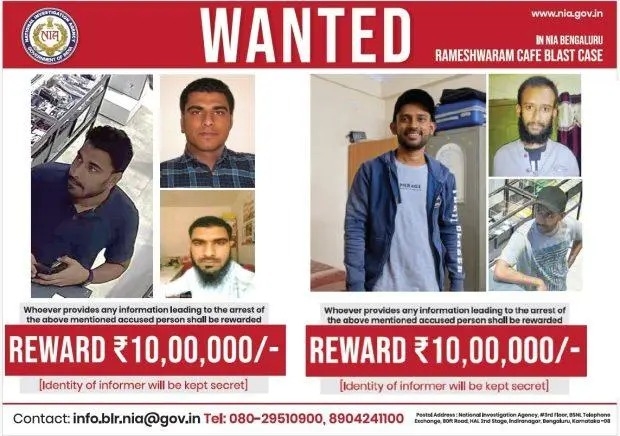Is West Bengal providing safe haven to terrorists? NIA arrest Rameshwaram Cafe blast case accused from near Kolkata
Last month, the NIA released the photographs and details of Taha, 30, and Shazib and also announced a reward of Rs 10 lakh for each of them. “Shazib is the accused who placed the IED at the café and Taha is the mastermind behind the planning and execution of the blast and the subsequent evasion from the clutches of law,” the spokesperson said.
Total Views |
The National Investigation Agency (NIA) on Friday arrested two absconding accused in the Rameshwaram Cafe blast case from near Kolkata. The blast at the Bengaluru Cafe on March 1 had left nine people injured.

“The absconders in Rameswaram Cafe blast case: Adbul Matheen Taha and Mussavir Hussain Shazib were traced out to their hideout near Kolkata and were apprehended by NIA team. On early morning hours of April 12, NIA were successful in tracing the absconding accused near Kolkata where they were hiding under false identities,” an NIA spokesperson said.
Last month, the NIA released photographs and details of Taha, 30, and Shazib. Besides, it also announced a reward of Rs 10 lakh for each of them. “Shazib is the accused who placed the IED at the café and Taha is the mastermind behind the planning and execution of the blast and the subsequent evasion from the clutches of law,” the spokesperson said.
The NIA coordinated with central intelligence agencies and state police agencies of West Bengal, Telangana, Karnataka, and Kerala.
The NIA said that after scanning CCTV footage from over 300 cameras, it found that Shazib and Taha, two ISIS members who emergedon the radar of security agencies in 2020, had carried out the blast.
“The NIA has also named two more people as the accused in the case. One of them, Maaz Muneer Ahmed, 26, was in prison at the time of the incident. The other accused is Muzammil Shareef, 30, who was arrested by the NIA on March 27 for providing logistics like cell phones, fake SIM cards and other materials that were used to plan and execute the blast,” an official said.
“Investigation has also revealed that Taha used the cryptocurrency route to finance the operation as part of efforts to avoid detection. It has been found that Taha used various conduits, including stolen identities and the IDs of people recruited for the ISIS cause in different parts of India, to transfer cryptocurrency to Muzammil Shareef to arrange logistics for the March 1 cafe blast,” an official added.
.
.

